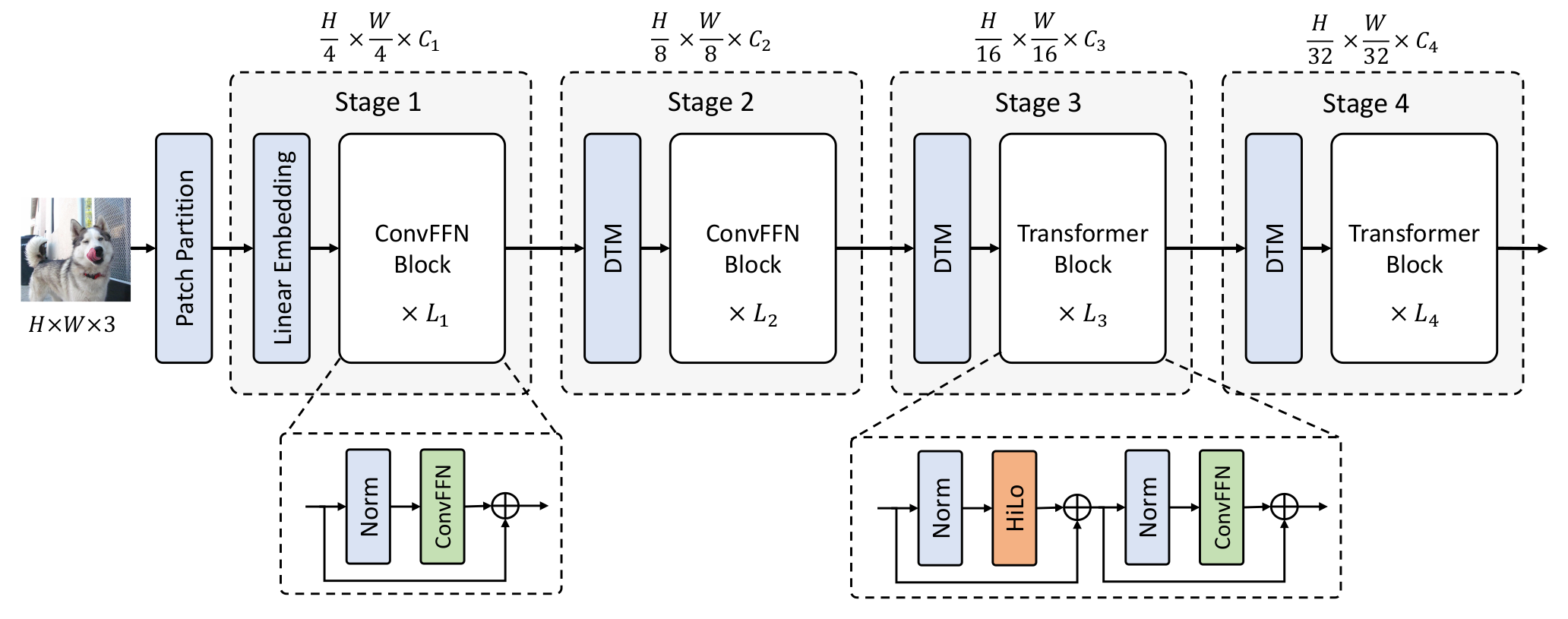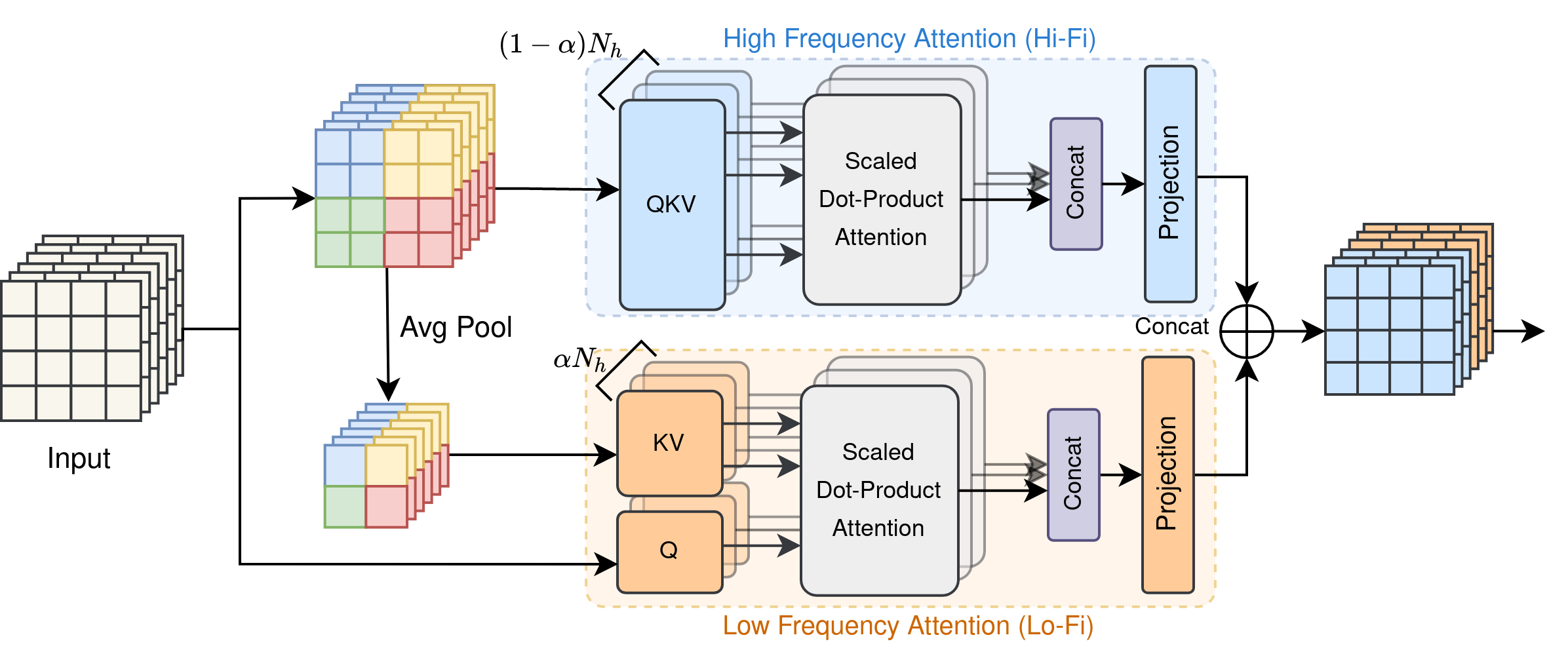This is the official PyTorch implementation of Fast Vision Transformers with HiLo Attention.
By Zizheng Pan, Jianfei Cai, and Bohan Zhuang.
-
17/11/2023. Update detection scripts with mmdet v3.2.0.
-
20/04/2023. Update training scripts with PyTorch 2.0. Support ONNX and TensorRT model conversion, see here.
-
15/12/2022. Releasing ImageNet pretrained weights of using different values of alpha.
-
11/11/2022. LITv2 will be presented as Spotlight!
-
13/10/2022. Update code for higher version of timm. Compatible with PyTorch 1.12.1 + CUDA 11.3 + timm 0.6.11.
-
30/09/2022. Add benchmarking results for single attention layer. HiLo is super fast on both CPU and GPU!
-
15/09/2022. LITv2 is accepted by NeurIPS 2022! 🔥🔥🔥
-
16/06/2022. We release the source code for classification/detection/segmentation, along with the pretrained weights. Any issues are welcomed!
We introduce LITv2, a simple and effective ViT which performs favourably against the existing state-of-the-art methods across a spectrum of different model sizes with faster speed.
The core of LITv2: HiLo attention HiLo is inspired by the insight that high frequencies in an image capture local fine details and low frequencies focus on global structures, whereas a multi-head self-attention layer neglects the characteristic of different frequencies. Therefore, we propose to disentangle the high/low frequency patterns in an attention layer by separating the heads into two groups, where one group encodes high frequencies via self-attention within each local window, and another group performs the attention to model the global relationship between the average-pooled low-frequency keys from each window and each query position in the input feature map.
To quickly understand HiLo attention, you only need to install PyTorch and try the following code in the root directory of this repo.
from hilo import HiLo
import torch
model = HiLo(dim=384, num_heads=12, window_size=2, alpha=0.5)
x = torch.randn(64, 196, 384) # batch_size x num_tokens x hidden_dimension
out = model(x, 14, 14)
print(out.shape)
print(model.flops(14, 14)) # the numeber of FLOPsOutput:
torch.Size([64, 196, 384])
83467776- Linux with Python ≥ 3.6
- PyTorch >= 1.8.1
- timm >= 0.3.2
- CUDA 11.1
- An NVIDIA GPU
Note: You can use the same environment to debug LITv1. Otherwise, you can create a new python virtual environment by the following script.
conda create -n lit python=3.7
conda activate lit
# Install Pytorch and TorchVision
pip install torch==1.8.1+cu111 torchvision==0.9.1+cu111 torchaudio==0.8.1 -f https://download.pytorch.org/whl/torch_stable.html
pip install timm
pip install ninja
pip install tensorboard
# Install NVIDIA apex
git clone https://github.com/NVIDIA/apex
cd apex
pip install -v --disable-pip-version-check --no-cache-dir --global-option="--cpp_ext" --global-option="--cuda_ext" ./
cd ../
rm -rf apex/
# Build Deformable Convolution
cd mm_modules/DCN
python setup.py build install
pip install opencv-python==4.4.0.46 termcolor==1.1.0 yacs==0.1.8For image classification on ImageNet, please refer to classification.
For object detection on COCO 2017, please refer to detection.
For semantic segmentation on ADE20K, please refer to segmentation.
Note: For your convenience, you can find all models and logs from Google Drive (4.8G in total). Alternatively, we also provide download links from github.
All models are trained with 300 epochs with a total batch size of 1024 on 8 V100 GPUs.
| Model | Resolution | Params (M) | FLOPs (G) | Throughput (imgs/s) | Train Mem (GB) | Test Mem (GB) | Top-1 (%) | Download |
|---|---|---|---|---|---|---|---|---|
| LITv2-S | 224 | 28 | 3.7 | 1,471 | 5.1 | 1.2 | 82.0 | model & log |
| LITv2-M | 224 | 49 | 7.5 | 812 | 8.8 | 1.4 | 83.3 | model & log |
| LITv2-B | 224 | 87 | 13.2 | 602 | 12.2 | 2.1 | 83.6 | model & log |
| LITv2-B | 384 | 87 | 39.7 | 198 | 35.8 | 4.6 | 84.7 | model |
By default, the throughput and memory footprint are tested on one RTX 3090 based on a batch size of 64. Memory is measured by the peak memory usage with
torch.cuda.max_memory_allocated(). Throughput is averaged over 30 runs.
| Alpha | Params (M) | Lo-Fi Heads | Hi-Fi Heads | FLOPs (G) | ImageNet Top1 (%) | Download |
|---|---|---|---|---|---|---|
| 0.0 | 28 | 0 | 12 | 3.97 | 81.16 | github |
| 0.2 | 28 | 2 | 10 | 3.88 | 81.89 | github |
| 0.4 | 28 | 4 | 8 | 3.82 | 81.81 | github |
| 0.5 | 28 | 6 | 6 | 3.77 | 81.88 | github |
| 0.7 | 28 | 8 | 4 | 3.74 | 81.94 | github |
| 0.9 | 28 | 10 | 2 | 3.73 | 82.03 | github |
| 1.0 | 28 | 12 | 0 | 3.70 | 81.89 | github |
Pretrained weights from the experiments of Figure 4: Effect of α based on LITv2-S.
All models are trained with 1x schedule (12 epochs) with a total batch size of 16 on 8 V100 GPUs.
| Backbone | Window Size | Params (M) | FLOPs (G) | FPS | box AP | Config | Download |
|---|---|---|---|---|---|---|---|
| LITv2-S | 2 | 38 | 242 | 18.7 | 44.0 | config | model & log |
| LITv2-S | 4 | 38 | 230 | 20.4 | 43.7 | config | model & log |
| LITv2-M | 2 | 59 | 348 | 12.2 | 46.0 | config | model & log |
| LITv2-M | 4 | 59 | 312 | 14.8 | 45.8 | config | model & log |
| LITv2-B | 2 | 97 | 481 | 9.5 | 46.7 | config | model & log |
| LITv2-B | 4 | 97 | 430 | 11.8 | 46.3 | config | model & log |
| Backbone | Window Size | Params (M) | FLOPs (G) | FPS | box AP | mask AP | Config | Download |
|---|---|---|---|---|---|---|---|---|
| LITv2-S | 2 | 47 | 261 | 18.7 | 44.9 | 40.8 | config | model & log |
| LITv2-S | 4 | 47 | 249 | 21.9 | 44.7 | 40.7 | config | model & log |
| LITv2-M | 2 | 68 | 367 | 12.6 | 46.8 | 42.3 | config | model & log |
| LITv2-M | 4 | 68 | 315 | 16.0 | 46.5 | 42.0 | config | model & log |
| LITv2-B | 2 | 106 | 500 | 9.3 | 47.3 | 42.6 | config | model & log |
| LITv2-B | 4 | 106 | 449 | 11.5 | 46.8 | 42.3 | config | model & log |
All models are trained with 80K iterations with a total batch size of 16 on 8 V100 GPUs.
| Backbone | Params (M) | FLOPs (G) | FPS | mIoU | Config | Download |
|---|---|---|---|---|---|---|
| LITv2-S | 31 | 41 | 42.6 | 44.3 | config | model & log |
| LITv2-M | 52 | 63 | 28.5 | 45.7 | config | model & log |
| LITv2-B | 90 | 93 | 27.5 | 47.2 | config | model & log |
| Model | Params (M) | FLOPs (G) | A100 | V100 | RTX 6000 | RTX 3090 | Top-1 (%) |
|---|---|---|---|---|---|---|---|
| ResNet-50 | 26 | 4.1 | 1,424 | 1,123 | 877 | 1,279 | 80.4 |
| PVT-S | 25 | 3.8 | 1,460 | 798 | 548 | 1,007 | 79.8 |
| Twins-PCPVT-S | 24 | 3.8 | 1,455 | 792 | 529 | 998 | 81.2 |
| Swin-Ti | 28 | 4.5 | 1,564 | 1,039 | 710 | 961 | 81.3 |
| TNT-S | 24 | 5.2 | 802 | 431 | 298 | 534 | 81.3 |
| CvT-13 | 20 | 4.5 | 1,595 | 716 | 379 | 947 | 81.6 |
| CoAtNet-0 | 25 | 4.2 | 1,538 | 962 | 643 | 1,151 | 81.6 |
| CaiT-XS24 | 27 | 5.4 | 991 | 484 | 299 | 623 | 81.8 |
| PVTv2-B2 | 25 | 4.0 | 1,175 | 670 | 451 | 854 | 82.0 |
| XCiT-S12 | 26 | 4.8 | 1,727 | 761 | 504 | 1,068 | 82.0 |
| ConvNext-Ti | 28 | 4.5 | 1,654 | 762 | 571 | 1,079 | 82.1 |
| Focal-Tiny | 29 | 4.9 | 471 | 372 | 261 | 384 | 82.2 |
| LITv2-S | 28 | 3.7 | 1,874 | 1,304 | 928 | 1,471 | 82.0 |
The following visualization results can refer to vit-attention-benchmark.
If you use LITv2 in your research, please consider the following BibTeX entry and giving us a star 🌟.
@inproceedings{pan2022hilo,
title={Fast Vision Transformers with HiLo Attention},
author={Pan, Zizheng and Cai, Jianfei and Zhuang, Bohan},
booktitle={NeurIPS},
year={2022}
}If you find the code useful, please also consider the following BibTeX entry
@inproceedings{pan2022litv1,
title={Less is More: Pay Less Attention in Vision Transformers},
author={Pan, Zizheng and Zhuang, Bohan and He, Haoyu and Liu, Jing and Cai, Jianfei},
booktitle={AAAI},
year={2022}
}This repository is released under the Apache 2.0 license as found in the LICENSE file.
This repository is built upon DeiT, Swin and LIT, we thank the authors for their open-sourced code.




